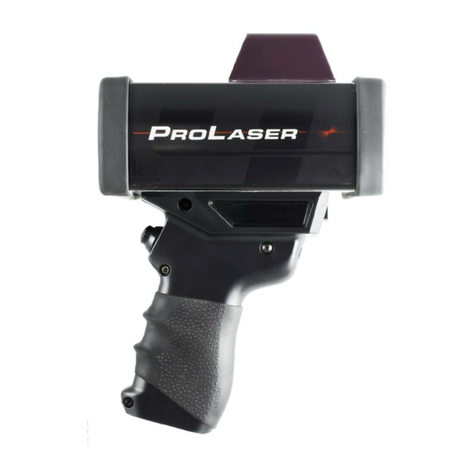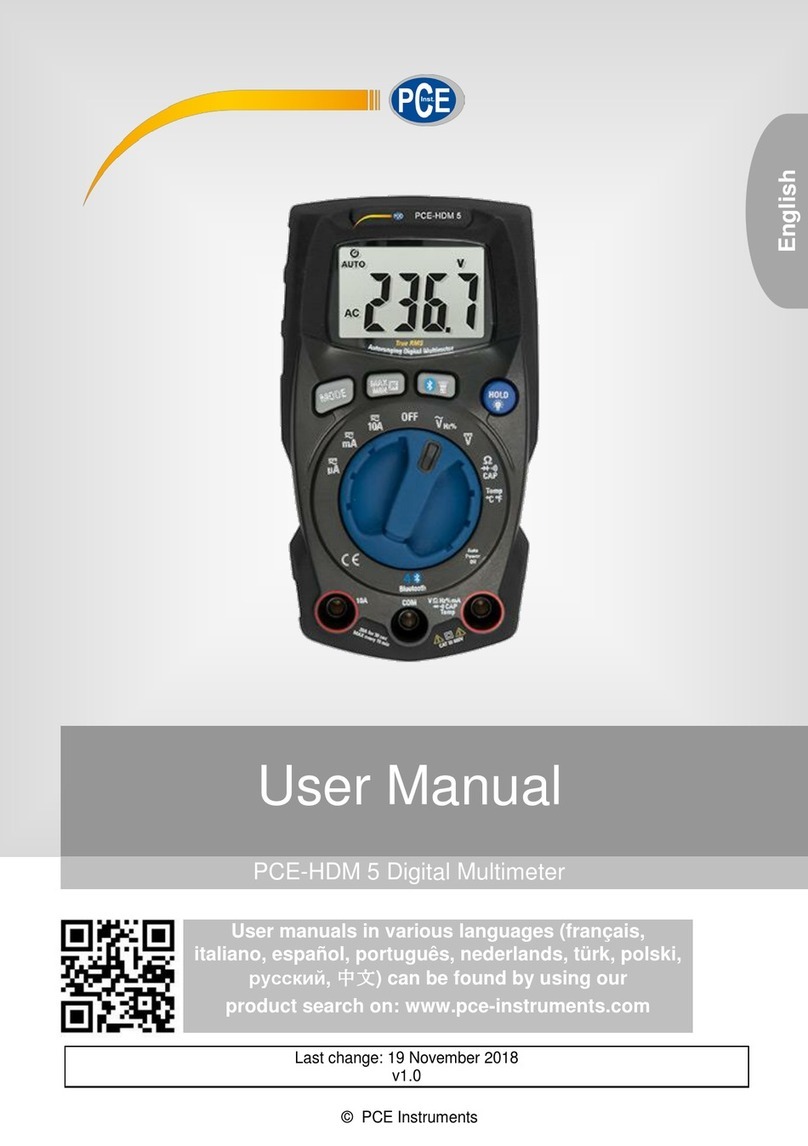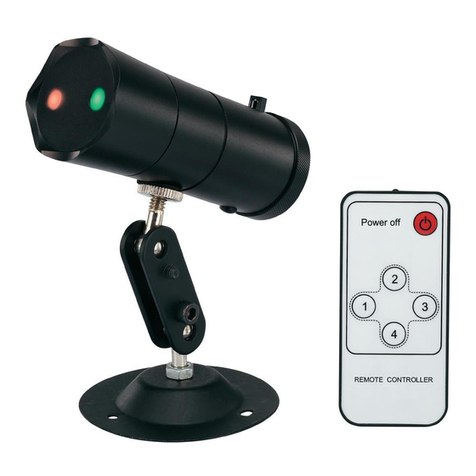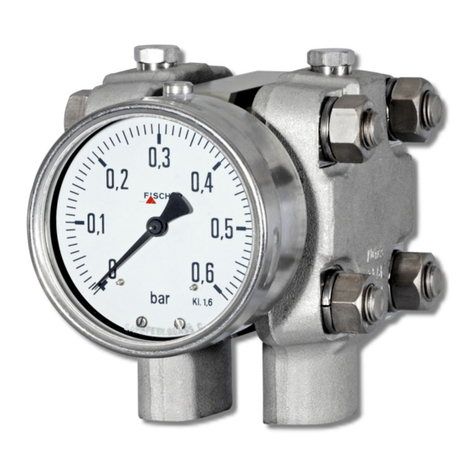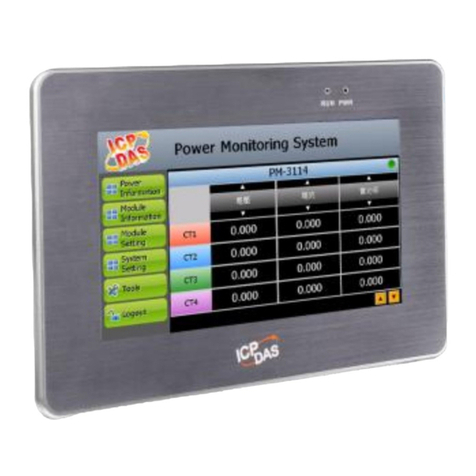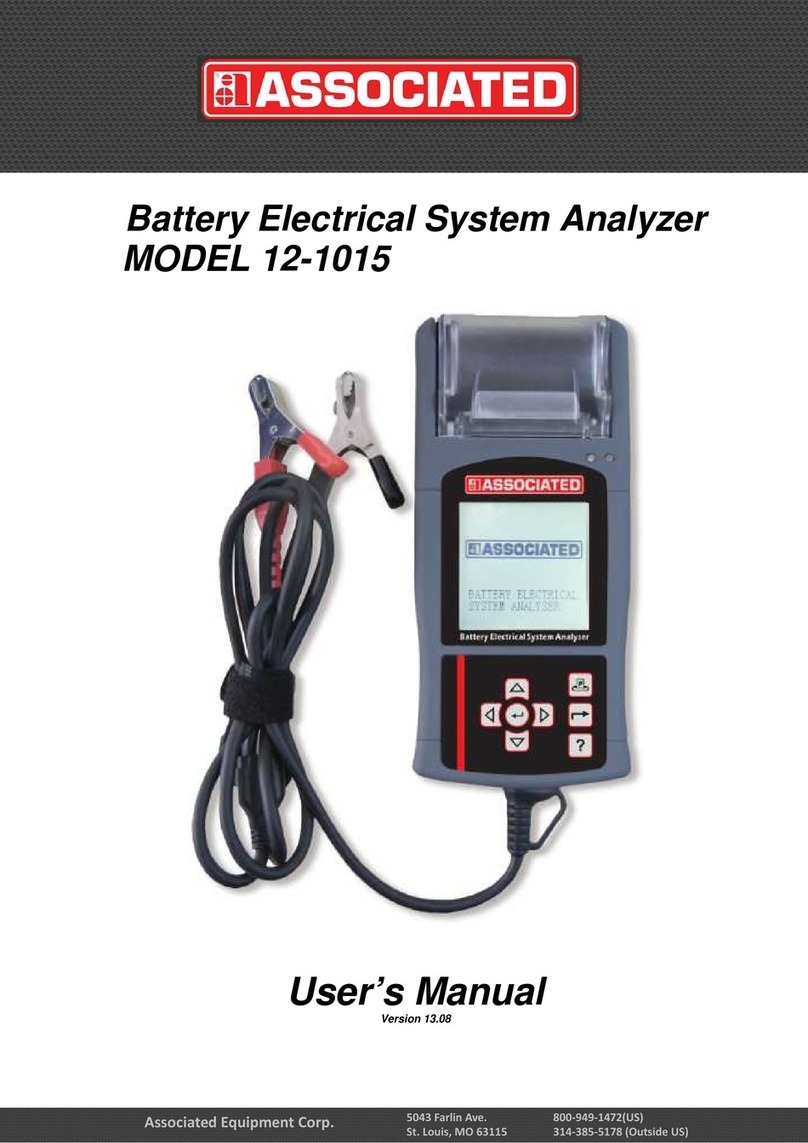Made JUPITER X User manual

M A D E
167, Impasse de la garrigue
F 83210 LA FARLEDE
Phone. : +33 (0) 494 083 198
FQ 47B-EN - V1.12 - 14/10/2020
Pre-identify LV and MV off line
Cables and feeders
JUPITER X
CAUTION: Read this manual before using the device
GU_JUPITER-X_V3_00EN
USER GUIDE

2 / 33
M O D I F I C A T I O N ’ S D I R E C TO RY
Rév.
Subject of Amendments
Date
Author
1.00
Creation
2021/04/28
T.Hubert
1.01
§4 Size and Weight,
TX Battery access
2021/06/22
T Hubert
1.02
Correction §4
2022/01/27
T Hubert
1.03
Add special use cases
2022/03/23
L. Zomero
2.00
Correction §3.2.3
2022/05/16
T Hubert
2.01
Correction §3.2.3.2 &
3.2.3.3
2022/06/30
L. Zomero
3.00
Add security info+ESC
2022/10/14
T Hubert
This manual is important for your safety. Read it carefully in its
entirety before using the equipment and keep it for future reference.

3 / 33
SUMMARY
1. SAFETY INFORMATION...............................................................................4
Safety recommendations....................................................................4
Following the safety recommendations ............................................4
Warning labels.....................................................................................5
Intended use........................................................................................6
2. OVERVIEW....................................................................................................7
Working Principle................................................................................7
Composition ........................................................................................8
2.2.1. Transmitter...............................................................................8
2.2.2. Receiver ...................................................................................9
3. IMPLEMENTATION.....................................................................................11
JUPITER X TRANSMITER .................................................................11
3.1.1. Overview of the Transmitter .................................................12
3.1.2. Transmitter general functioning...........................................13
3.1.3. Precautions for using the transmitter..................................15
3.1.4. Battery....................................................................................16
3.1.5. Fuse........................................................................................17
JUPITER X RECEIVER.......................................................................17
3.2.1. Use of receiver.......................................................................20
3.2.2. ESC Mode Receiver Special Case........................................26
3.2.3. Batteries.................................................................................30
4. TECHNICAL FEATURES ............................................................................31
5. MAINTENANCE, WARRANTY AND COPYRIGHT .....................................33
Maintenance ......................................................................................33
Warranty.............................................................................................33
Copyright...........................................................................................33

4 / 33
This document is the JUPITER X User's Guide. It describes the
implementation of the device, as well as the different modes of
operation to facilitate its use.
1. SAFETY INFORMATION
Safety recommendations
Please read this guide carefully before unpacking, configuring or using
this equipment. Note all indications of danger and other warnings.
Failing to observe these recommendations could result in serious
injury to the operator or could damage the equipment. To ensure that
the protection provided by this equipment is appropriate, do not use or
install it other than in accordance with the conditions indicated in this
manual.
Dismantling the cases is forbidden. This operation is limited exclusively
to personnel qualified by MADE.
Following the safety recommendations
DANGER: Indicates a dangerous or potentially dangerous situation
which, if not avoided, could cause serious or deadly injuries.
WARNING: Indicates a potentially dangerous situation which could
cause superficial to moderate injuries.
Remark: Information requiring particular attention.

5 / 33
Warning labels
Read all labels and wordings shown on the instrument. Injuries or
equipment damage could occur if these instructions are not respected.
Symbol requiring reference to the
instruction manual for
instructions concerning operation
or safety recommendations.
Dangerous Voltage
Ac current
IP standard –Protection against
dust and water
Do not throw away with
household waste
IP XX

6 / 33
Intended use
JUPITER X is an equipment allowing:
• Pre-identification of de-energized cables in excavations, gutters and
cable trays, with short-circuited ends.
• Identification of dead conductors and continuity test to the transmitter
called S1.
shorted end (closed circuit)
open circuit end
The device/system described in this documentation should only be
operated by qualified personnel for each specific task. The
documentation relating to this task must be observed, in particular the
safety instructions and warnings. Qualified persons are, due to their
training and experience, able to recognize the risks associated with the
handling of this product / system and to avoid them.
JUPITER X is intended for personnel authorized to work on electrical
networks.
The documentation relating to each function must be observed, in
particular the safety instructions and warnings. Qualified persons are,
due to their training and experience, able to recognize the risks
associated with the handling of this product and to avoid them.
All safety instructions imposed by the network operating company must
be scrupulously respected.
The user of the material must have been trained in the handling of the
material.
Its use is exclusively reserved for de-energized networks.
The cable to be identified must be consigned by an authorized agent
and the 2 ends must be short-circuited and earthed.
A verification of the absence of voltage (VAT) must imperatively be
carried out before use.
Wearing personal protective equipment (PPE) is mandatory (class 00 or
higher electrical insulating gloves, helmet with protective face shield)
The material should not be used when at least one of its
constituent parts is damaged.

7 / 33
2. OVERVIEW
Working Principle
Identification of cables in a trench, gutter and in cable shelf.
With short-circuited ends
Identifying the phases and checking cable continuity to
transmitter S1
With short-circuited ends (closed circuit)
With open-circuit ends.
The configuration required for each of these modes is described in this
document.
Each of the functions is usually carried out on unpowered MV & LV
cables (customer loads Off-line).
The signals and the physical principles used are common for each
function.
The JUPITER system is made up of a Transmitter and a Receiver.
The removable transmitter is in a trolley case which also contains the
various accesories.
The Receiver is in a soft carrying case which fits into the Transmitter
case. This also contains the 3 sensors used for cable and
conductor/phase identification:
Cable identification
Continuity and core identification in open circuit.
Continuity and core identification in short circuit
Option:
•Core identification in short circuit adapted for LV 4 conductor
cables, with visually unidentifiable neutral
Co
rdo
n
ch
arg
eur
réc
ept
eur

8 / 33
Composition
2.2.1.Transmitter
3 current clamps with their connecting cable (ref JPR_PAI_320)
220V~ supply cable (ref JPRX_CHA_110)
1 Short-Circuiting cable (ref JPR_PCC_101)
1 transmitter (ref JPRX_EME_110)
Attention: the transmitter must only be operated with the
accessories supplied by the company MADE
JPR_PCC_101
JPRX_CHA_110
JPRX_EME_110
JPR_PAI_320

9 / 33
2.2.2.Receiver
Ref: JPRX_RXE-300
Attention: the receiver must only be operated with the sensors
supplied by the company MADE
2.2.2.1.Standard Sensors
•Sensor for « Core identification, short-circuited ends » :
•
Ref: JPRX_CAP_410

10 / 33
•Sensor for « Core identification, open circuit ends » :
Ref: JPRX_CAP_220
•Sensor for identification :
Ref: JPRX_SAB_100
2.2.2.2.Optional Sensor
•Sensor for core identification, short-circuited ends, adapted
for LV 4 conductor cables, with unidentifiable neutral visually.
Ref: JPR_CAP_120

11 / 33
3. IMPLEMENTATION
JUPITER X TRANSMITER
From turn-on by the operator, the Transmitter is activated and
generates the frequency signals necessary for identifying unpowered
MV & LV cables.
It is possible to turn the JUPITER X Transmitter on S2 mode (with
different frequencies) for a utilization with two Transmitters at the same
time at the ends of a cable, one in S1 mode and the second on S2
mode.
The type of utilization allows cores identification in open circuit once the
cable is cut at both ends without moving the Transmitter (useful
operation with replacing a joint for example).This Transmitter allows
only an utilization in S1 mode, or S2 mode with another Transmitter in
S1 mode.
Only one JUPITER X Transmitter in S2 mode does not
allow core identification in open and short circuit function!
The possible operations are:
•Identification of cables (Short-circuited ends)
•Continuity and identifying the cores with open circuit ends
(after cutting the cable)
•Identifying the cores with short circuited.
Once the Transmitter is started, no further action by the operator
is necessary to activate the functions described below.
When turned-on, the Transmitter is on S1 mode. A press on S1/S2
button activates S2 mode. Another press turn the Transmitter back to
S1 mode.
These functions are possible on an unpowered MV or LV network and
for all types of cables:
HN, Paper, PE.
When used on an LV network, it is not necessary to disconnect the
customer loads.

12 / 33
3.1.1.Overview of the Transmitter
Fault indicator for the injection circuits
(JPRX_EME_110)
Frequency set indicator and
Transmission indicator
Charge indicating lamps for the
batteries and protection fuse
Current clamps
JPR_PAI_320
Short-circuit
(JPR_PCC_101)
Charger port
ON/OFF button
220V~ supply cable
(JPRX_CHA_110)

13 / 33
3.1.2.Transmitter general functioning
3.1.2.1.Power supply
The JUPITER X Transmitter runs on 7,2Ah 12V DC batteries.
When turned on, the charge level of the battery is indicated on the front
face. The minimum autonomy of the transmitter is 8h.
The transmitter can run on internal batteries or during the charge when
using the external charger connected on the side of the case.
To charge the transmitter, please refer directly to the instruction on the
charger
The continuous use of this type of charger enables the long term storage
of the Transmitter, whilst maintaining the battery in optimum charged
condition (charger connected).
Warning: when using the transmitter while charging the battery,
the charger must be placed indoors, away from any splashing
water and flammable agents.
The charger must be connected to an overvoltage category II
mains socket.
During recharging, the charger plug serves as a disconnect
device, it must remain easily accessible

14 / 33
3.1.2.2.Transmitter functions
The JUPITER X Transmitter consists of:
Three synthesized power generators
A monitoring unit for the internal components which :
Detects any faults in the transmission circuits (over-
currents or low currents) and indicates which clamp is
concerned.
Monitors the discharge level of the battery –the
transmission is automatically stopped if the battery
reaches a discharge level that could affect its life time.
A front face –instrument panel with 4 different zones:
Faults zone
S1 or S2 signal selection button
ON/OFF button
Battery zone : Battery charge indicator and protection
fuse
A plug for charging the battery
3.1.2.3.Transmitter connection
The transmitter is connected on the near end of the cables using
the current clamps on the connection case. Both cable ends are
short-circuited and can be earthed (Do not include the cable
screen).
Ensure that both cable ends are short-circuited, using the
appropriate connection wires.
The loop located at the end of the short circuit
must be connected to the security padlock

15 / 33
Turn on the transmitter.
It is better to place the current clamps before starting the transmitter.
If not, opening the clamps during transmitter causes the clamp fault
lights to illuminate.
L1 L2 L3 L1 L2 L3
L1 L2 L3 N N L1 L2 L3
HTA
BT 4 conducteurs
So as to enhance the continuity, the end user needs to use the two
accessories, one inside the transmitter and one inside the receiver.
(Additional short circuit included in the product, ref JPR_PCC_101):
This will ensure that the balancing of the injected signal is perfect. Note
that the quality of the contact can be altered by corrosion or dirt, typically
on Medium Voltage.
3.1.3.Precautions for using the transmitter
THE CURRENT CLAMPS MUST ALL HAVE THE SAME
ORIENTATION WITH RELATION TO THE CABLE END (Indicated by
the arrows on the clamps).

16 / 33
CHECK THAT THE CLAMPS ARE ON AN UNSCREENED LENGTH
OF CABLE. IF NECESSARY, USE WOODEN CLAMPS OR TAPE TO
HOLD THEM IN POSITION.
TO AVOID RISK OF ERROR IN CABLE DESIGNATION, USE ONLY
ONE JUPITER X TRANSMITTER ON A SITE.
AFTER TURN-ON, CHECK ON THE FRONT FACE:
THAT THERE ARE NO TRANSMISSION CIRCUIT FAULTS
THE BATTERY CHARGE LEVEL
3.1.4.Battery
The transmitter is powered by a 12 Volt battery.
The replacement of the battery must be carried out by an
authorized and trained person
To Change the Batteries: remove the protective cover, unscrew the
battery compartment on the bottom of the transmitter and replace
the battery with similar one.
Pay attention to the direction

17 / 33
3.1.5.Fuse
The protection fuse is located on the underside of the housing.
In case of deterioration, it must be replaced by a strictly identical fuse:
5A 250VAC fast 5x20mm (breaking capacity >= 50A) or the transmitter
unit must be returned to after-sales service.
JUPITER X RECEIVER
The JUPITER X Receiver assembly consists of:
The Receiver to which are connected the sensors
Inductive sensor for identification
Probes for core identification and continuity with open circuit.
Flexible Identifying loops for short-circuited core
identification
On option: a double flexible loop for core identification on a 4
conductor LV cable.
The Receiver and its sensors are supplied in a carrying case, which
itself fits into the lid of the Transmitter case.
The JUPITER X Receiver is used to identify a cable of which the
extremities are in short-circuit and earthed, to identify the cores in an
open or closed circuit cable.
This is done in normal operation on unpowered HV & LV networks.
The JUPITER X Receiver is equipped with sensors dedicated to each
function to « extract » the signals emitted by the JUPITER X
Transmitter.
The results obtained, by the Receiver, require no interpretation, the
detection

18 / 33
Receiver with its various sensors
JPRX_RXE_300
JPRX_CAP_220
JPRX_SAB_100
JPRX_CAP_410

19 / 33
Ref: JPRX_RXE-300
Socket for sensor
connection
Indication of the transmitter
source of the signal
Measurement display in
core identification mode
Measurement display in
identification and
continuity mode
End of measurement
indicator
On and measurement
initiation button
Battery fault indication
Fuse testing
Calibration mode on
short cable

20 / 33
3.2.1.Use of receiver
The receiver must behandled with electricallyinsulating gloves.
The shape of the receiver housing allows the hand to be
positioned as far as possible from the contact area of the
sensors
Connecting a sensor to the Receiver automatically sets the operating
mode which is indicated by a LED.
These modes are:
•Continuity and Identification in short-circuit
•Continuity and Identification in open-circuit
•Pré-identification
One press of the « Measurements » button turns on and illuminates the
LED corresponding to the mode selected by the chosen sensor, which
confirms to the operator the type of measurement to carry out.
After 30 seconds with no press of the « Measurements » button, the
Receiver switches off until a new button press.
If there is no sensor connected, one press on « Measurements » button
illuminates during 1 second all LEDs to be sure they are all operational.
Gripping area
Area not to be touched during
measurement
Protective area
Do not
exceed the
protective
stop
This manual suits for next models
1
Table of contents
Other Made Measuring Instrument manuals
Popular Measuring Instrument manuals by other brands
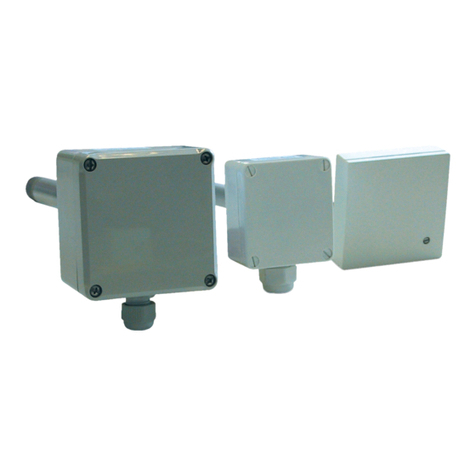
Carel
Carel AS Series quick start guide
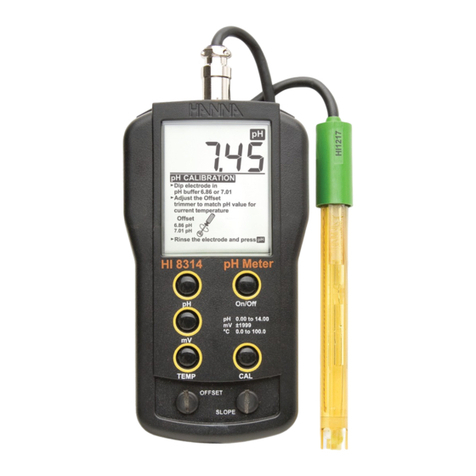
Hanna Instruments
Hanna Instruments HI 8314 instruction manual
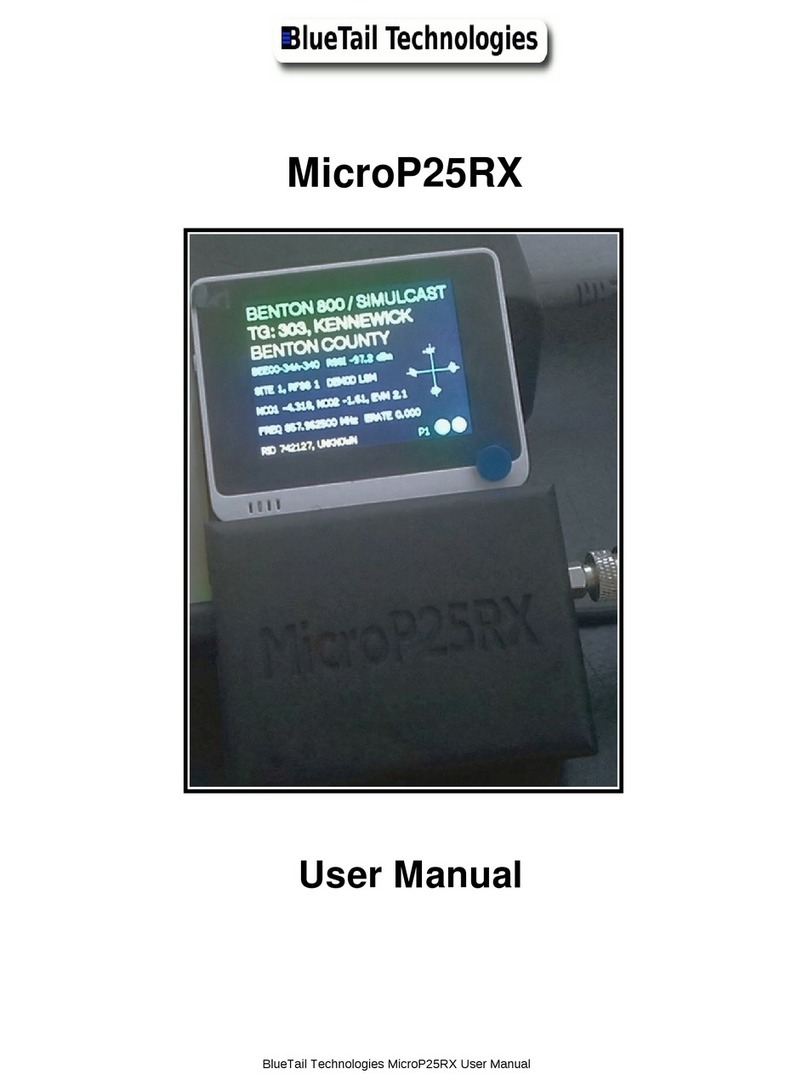
BlueTail Technologies
BlueTail Technologies MicroP25RX user manual

Keeler
Keeler IntelliPuff Service manual
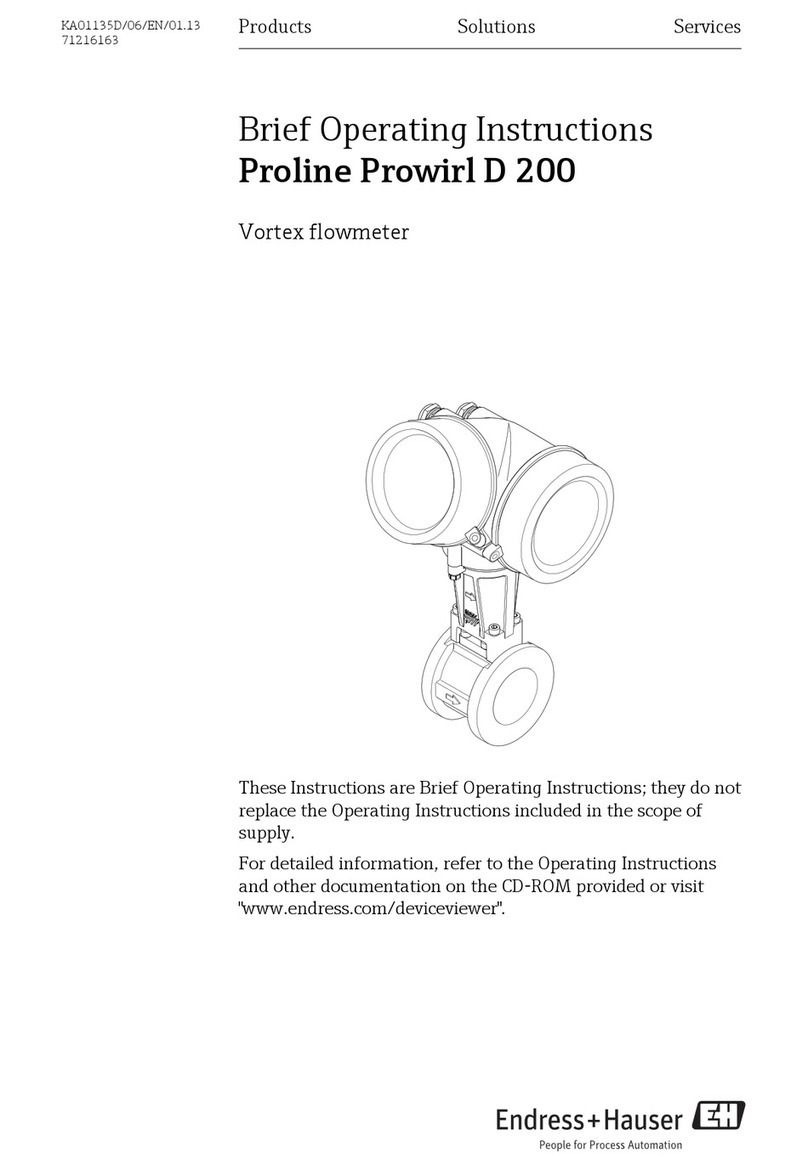
Endress+Hauser
Endress+Hauser Proline Prowirl D 200 Brief operating instructions
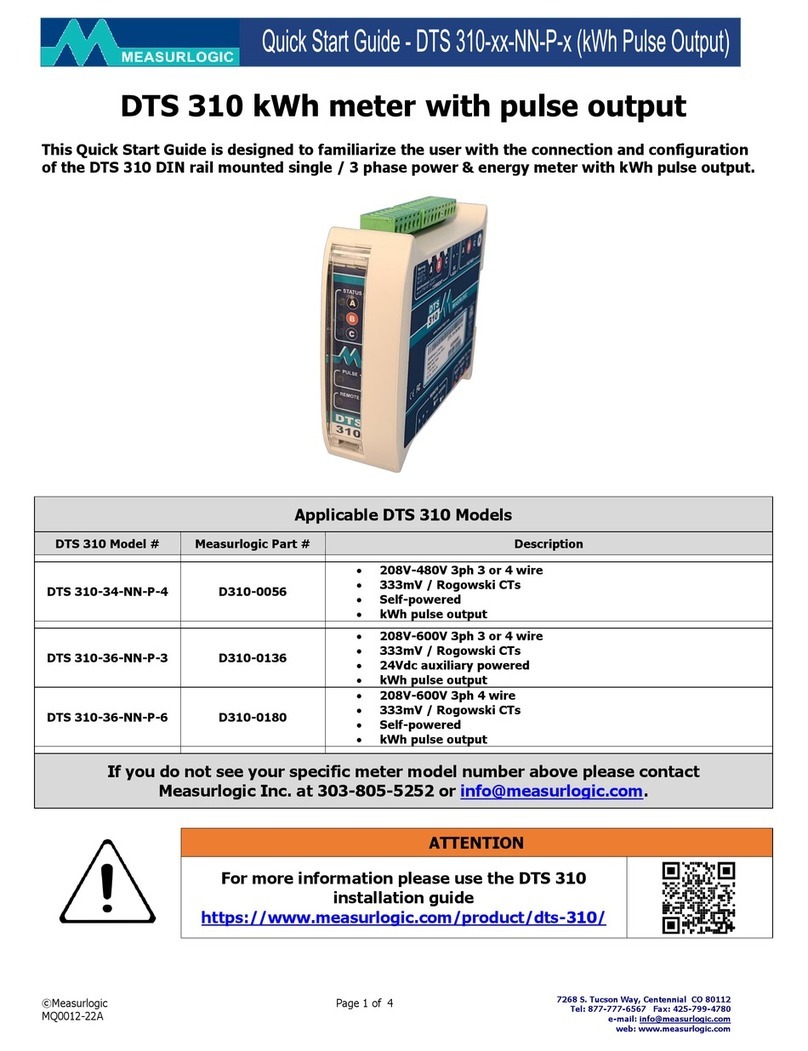
Measurlogic
Measurlogic DTS 310 quick start guide
